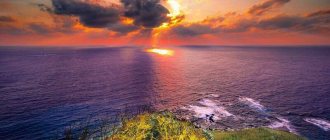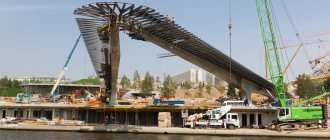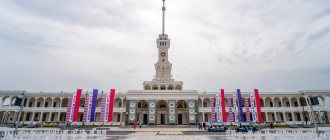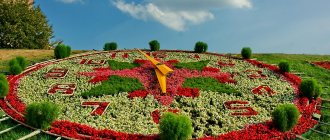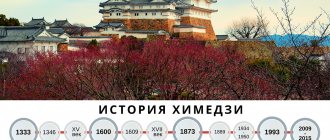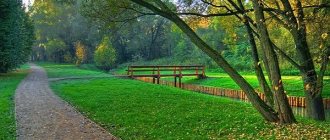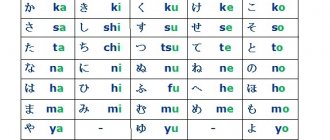Legends can be made about life in Japan. Technology has reached such a level here that the future seems to have arrived in this country a long time ago and people live in the 22nd century. Be that as it may, the Japanese sacredly cherish ancient traditions, and here you can see corners of untouched nature, villages in their original form, as well as ancient castles, which sharply contrast with modern megacities. One of these amazing places is Kanazawa Castle, around which Kenroku-en Park was created back in the 17th century.
Kanazawa Castle itself was built in 1592 and burned down in 1881. What can be seen here today is a historical reconstruction. More than a hundred years earlier, Kenroku-en Park had completely burned down, but gradually, starting in 1774, the park and its buildings were gradually restored. Today, Kenroku-En is one of the three famous parks in Japan and ranks third after Kairaku-en in Mito and Koraku-en in Okayama.
Photo: (CC BY-SA 3.0)
Photo: (CC BY-SA 3.0)
Photo: EllenChan/pixabay (Pixabay License)
The name Kenroku-en means "Garden of Six Virtues". These advantages, including beautiful scenery, privacy, antiquity, artificiality and space, were listed in the book “Chronicle of the Famous Gardens of Luoyang” by the Chinese poet Li Gefei.
Photo: (CC BY-SA 3.0)
Photo: (CC BY-SA 3.0)
Photo: Izu navi / flickr (CC BY 2.0)
For a long time, the park was the private property of the Maeda clan, but in 1871 it was opened to the public. It was here in 1861 that the first fountain in Japan began operating, the water for which comes under natural pressure from the surrounding mountains.
Photo: (CC BY-SA 3.0)
Photo: yosshi / flickr (CC BY-SA 2.0)
Photo: ddmacgre / flickr (CC BY 2.0)
Photo: (CC0)
The unique park looks so natural that it is difficult to believe that absolutely all of its elements, without exception, were created by human hands. Ponds, waterfalls, man-made streams and hills - all of this is in perfect harmony with each other.
Photo: raul1534 / pixabay (Pixabay License)
Photo: (CC BY 2.0)
Photo: (CC BY-SA 3.0)
Kenroku-En Park is an amazing place with attractions in every corner. However, several iconic places deserve special attention. Among them is the Misty Lake (Kasumi-ga-ike), located right in the center of the park. In the southern part of the reservoir, symbolizing the ocean, you can see the so-called “married pines” - trees growing with intertwined trunks.
Photo: (CC BY-SA 3.0)
Photo: (Public domain)
The symbol of the garden and the city is the unique Kotoji stone lantern.
Photo: (CC BY-SA 2.0)
Photo: (Public domain)
Yugao-tei Teahouse is the oldest building in Kenroku-En Park. In addition, the luxurious Seison-Kaku mansion, built by daimyo Maeda Nariyasu for his mother in 1863, also deserves attention.
Photo: (CC BY-SA 3.0)
Photo: pelican / flickr (CC BY-SA 2.0)
Photo: sodai gomi / flickr (CC BY 2.0)
The man-made miracle of Kenroku-En attracts tourists with its natural harmony. It’s a pleasure to relax your soul here, enjoy the unique atmosphere and receive a colossal charge of positive energy. And at every time of the year this lush splendor is beautiful in its own way!
Photo: Mike Reddy / flickr (CC BY 2.0)
Photo: Mike Reddy / flickr (CC BY 2.0)
Kenrokuen Garden
One of the main attractions of Kanazawa is Kenroku-en Park, located near the Korinbo quarter.
The best time to visit this magnificent park is early in the morning or late afternoon, when it is not so crowded, however, even at this time the silence can be broken by guides with megaphones or groups of tourists (every third Sunday - entrance to the park is free, it is better to check the park's opening hours in advance check with managers). Among the three best gardens in Japan (Koraku-en in Okayama and Kairaku-en in Mito), Kenroku-en, which has existed for more than three hundred years, since 1670, is rightfully recognized as the most luxurious. Located in the outer grounds of Kanazawa Castle and the private garden of the ruling Maeda clan, Kenroku-en opened to the public in 1871. The park received its name, literally translated as “six gardens in one,” due to six attractive properties: privacy, artificiality, spaciousness, antiquity, water and panoramic views of the garden. Despite the crowds of tourists, this is a great place to just take a walk, and the unique water supply system and reservoirs located on the hillsides, as well as fountains, will make such a walk unforgettable.
The main gate to Kenroku-en is on its western slope, the other is next to Rentimon, the ancient gate to the garden, just behind the souvenir shops. From any entrance you can immediately see Hisago-ike (Pumpkin Lake), which has a three-hundred-year history. The Midori-taki (Green Waterfall), an unusual element for a Japanese garden, built in 1774 at the same time as the neighboring Yugaotei Tea House, flows into the lake (you can pre-book a tea ceremony with the tour operator Fuji Travel).
It should be noted that the first fountain in Japan appeared in Kenroku-en. This fountain was built in 1861 and operates under the natural pressure of water flowing from the surrounding mountains. Further up is Kasumi-ga-ike (Mist Lake), the largest of Kenroku-en's four bodies of water, located in the very center of the garden. In front of the Kotoji toro, standing on two pillars, the most famous of the garden's 18 stone lanterns, there is always a crowd of tourists wanting to take a beautiful photo.
If you go from the reservoir in the opposite direction, you can go to the street leading to the ancient geisha quarter of Higashi Chaya and, weather permitting, to the coast of the Sea of Japan. There are many pine trees in the park, which have been carefully pruned over several centuries to give them a certain shape. Thus, in the southern part of the Foggy Lake, “married pines” with intertwined trunks grow.
On the territory of Kenroku-en is the magnificent Seison-kaku mansion, which was built by daimyo Maeda Nariyasu for his mother in 1863. Booklets in English describe all the decorative and architectural features of the house, including images of shellfish, fish and turtles on the wooden panels of the movable shoji partitions in the guest rooms on the first floor. A particularly pleasant view opens from Tsukushi-no-roka (the Ponytail corridor) over the mansion's gravel garden. The upper floors of the building are decorated more boldly, using bright colors and materials unusual for traditional Japanese houses, as well as glass windows brought specially from Holland. They were installed so that the residents of the house could look at the falling snow in winter.
Kenroku-en Park (Japanese: 兼六園) is the largest park in Kanazawa, one of the Three Famous Parks in Japan. The name means Garden of Six Virtues
Legends can be made about life in Japan. Technology has reached such a level here that the future seems to have arrived in this country a long time ago and people live in the 22nd century. Be that as it may, the Japanese sacredly cherish ancient traditions, and here you can see corners of untouched nature, villages in their original form, as well as ancient castles, which sharply contrast with modern megacities. One of these amazing places is Kanazawa Castle, around which Kenroku-en Park was created back in the 17th century.
Kanazawa Castle itself was built in 1592 and burned down in 1881. What can be seen here today is a historical reconstruction. More than a hundred years earlier, Kenroku-en Park had completely burned down, but gradually, starting in 1774, the park and its buildings were gradually restored. Today, Kenroku-En is one of the three famous parks in Japan and ranks third after Kairaku-en in Mito and Koraku-en in Okayama.
See also: Glass house with polka dots by artist Yayoi Kusama
Photo: Daderot at the English language Wikipedia (CC BY-SA 3.0)
Photo: Oilstreet (CC BY-SA 3.0)
Photo: EllenChan/pixabay (Pixabay License)
The name Kenroku-en means "Garden of Six Virtues". These advantages, including beautiful scenery, privacy, antiquity, artificiality and space, were listed in the book “Chronicle of the Famous Gardens of Luoyang” by the Chinese poet Li Gefei.
Photo: 663highland (CC BY-SA 3.0)
Photo: 663highland (CC BY-SA 3.0)
Photo: Izu navi / flickr (CC BY 2.0)
For a long time, the park was the private property of the Maeda clan, but in 1871 it was opened to the public. It was here in 1861 that the first fountain in Japan began operating, the water for which comes under natural pressure from the surrounding mountains.
Photo: Daderot at the English language Wikipedia (CC BY-SA 3.0)
Photo: yosshi / flickr (CC BY-SA 2.0)
Photo: ddmacgre / flickr (CC BY 2.0)
Photo: Daderot (CC0)
The unique park looks so natural that it is difficult to believe that absolutely all of its elements, without exception, were created by human hands. Ponds, waterfalls, man-made streams and hills - all of this is in perfect harmony with each other.
See also: Ingenious ways the Japanese solve everyday problems
Photo: raul1534 / pixabay (Pixabay License)
Photo: Joel Jenkins (CC BY 2.0)
Photo: Bernard Gagnon (CC BY-SA 3.0)
Kenroku-En Park is an amazing place with attractions in every corner. However, several iconic places deserve special attention. Among them is the Misty Lake (Kasumi-ga-ike), located right in the center of the park. In the southern part of the reservoir, symbolizing the ocean, you can see the so-called “married pines” - trees growing with intertwined trunks.
Photo: 663highland (CC BY-SA 3.0)
Photo: Fg2 (Public domain)
The symbol of the garden and the city is the unique Kotoji stone lantern.
Photo: KimonBerlin (CC BY-SA 2.0)
Photo: Fg2 (Public domain)
Yugao-tei Teahouse is the oldest building in Kenroku-En Park. In addition, the luxurious Seison-Kaku mansion, built by daimyo Maeda Nariyasu for his mother in 1863, also deserves attention.
Photo: Oilstreet (CC BY-SA 3.0)
Photo: pelican / flickr (CC BY-SA 2.0)
Photo: sodai gomi / flickr (CC BY 2.0)
The man-made miracle of Kenroku-En attracts tourists with its natural harmony. It’s a pleasure to relax your soul here, enjoy the unique atmosphere and receive a colossal charge of positive energy. And at every time of the year this lush splendor is beautiful in its own way!
See also: Elephant protects baby elephant from hyenas, photos of funny and frightened baby elephants and other pictures from the life of proboscis
Photo: Mike Reddy / flickr (CC BY 2.0)
Photo: Mike Reddy / flickr (CC BY 2.0)
How to get to Kenroku-en Park:
The nearest airport is Komatsu, located 25 kilometers from the park and can be reached by car or bus.
source
01.07.2019
If you find an error, please select a piece of text and press Ctrl+Enter.
